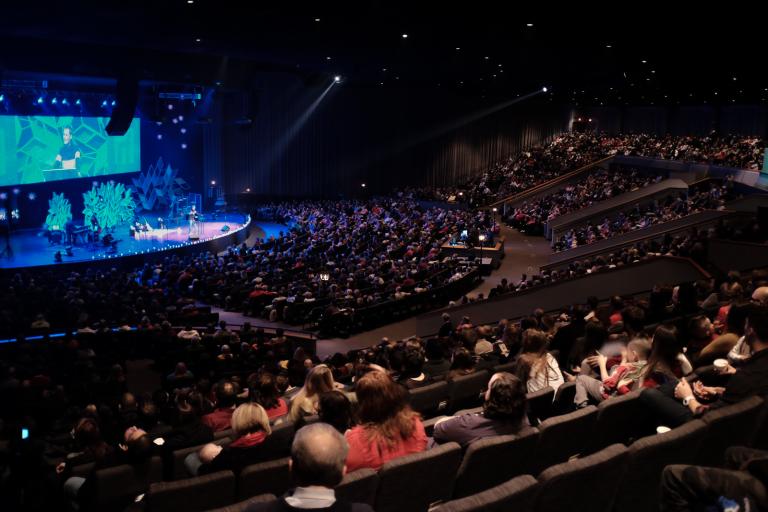Life.Church here in Oklahoma is a pioneer in how churches can use technology. They put out YouVersion, the world’s most popular Bible app, and their very name emulates that of a website. Life.Church is one of the earliest adopters of an innovation that is catching on around the world: the multi-site church, in which a single pastor presides over multiple congregations, preaching to them all through a video screen.
Life.Church has 34 locations throughout the country. Each location, called a “campus,” has its own “campus pastor” and “worship team.” People gather for worship at their local campus, but they all watch the same sermon from senior pastor Craig Groeschel, broadcasting from a studio in Edmond, Oklahoma.
I like this description of the studio technology, from the Daily Oklahoman‘s Carla Hinton, Oklahoma megachurches find success at the vanguard of video worship services:
[Pastor-Innovation Leader Bobby] Gruenewald said Life.Church’s recent enhancements are geared to using the latest technology to reach more people for Christ. This includes robotic cameras, an LED wall for visual imagery, and stadium seating. He said the newly designed facility helps creates a more intimate experience for all church members, whether they are sitting in seats experiencing the spiritual message live or if they are watching Groeschel on a screen at another Life.Church location.
Creating “a more intimate experience”!
This multi-site model is being adopted at more and more congregations. In 1990, there were only 10 multi-site churches in the United States; today there are more than 5,000. The model allows megachurches to become even more mega-, or giga-, or tera-, by breaking out of the limitation of being a single congregation to multiply over a number of congregations, all under the same pastor!
Do any of you attend a church like this? If so, what’s it like? And let me ask this, since I’m not as well connected as I used to be: Are any Lutheran churches–particularly LCMS, WELS, or ELS congregations–using this model?
I have two main problems with this approach. The first has to do with the office of the holy ministry. I don’t see how you can have a meaningful involvement in a congregation without knowing your pastor or without your pastor knowing you. Yes, the various campuses have their campus pastors if you need counseling or the like. But the pastorate is a preaching office, and when the minister who preaches and who leads the congregation lives in a different city, I think that congregation is missing something.
What is the purpose of this arrangement? Why does one pastor want to lead multiple congregations? Wouldn’t it be better for the local campuses to call their own pastors? Actually, they do have campus pastors. Why aren’t they allowed to preach?
Traditionally, when a congregation became so large that the pastor could not know all of his flock, it would split into two congregations. There would now be two congregations, and thus the churches multiplied. What is the advantage of having numerous buildings, distinct communities, and being in various locations, yet being under one pastor who is remote from them all?
“Leadership” has become a major preoccupation in the pastoral ministry today, and I’m not sure that view is completely healthy or orthodox. Yes, a shepherd leads his flock, and pastors lead and exercise authority in their congregations. But they do so in vocation; that is, as masks of God, who works through their office by means of the Word and Sacraments. Pastors are not leaders in the sense that politicians or C.E.O.’s of corporations are leaders. The leader of a nation might seek to increase his rule by building an empire. A business leader might seek to increase the number of his companies. But the church is a different kind of institution and needs a different kind of leadership. Otherwise, things can go terribly wrong.
To be sure, having many different congregations all under the same leader has its pedigree. That was the aspiration of the papacy. If only the Church of Rome throughout its history could have had today’s video technology, the pope could be the preacher to all Catholic congregations, thus establishing unity amongst all of the diversity. Of course, this would require a common language, possibly bringing back Latin.
In addition to the multi-site model having an inadequate view of the pastoral office, it also shows an inadequate view of preaching. A sermon is not just conveying information. Nor is it just an inspiring words. Nor is it a performance. Nor is it a TED talk.
A sermon is a means of grace. The Holy Spirit uses the preaching of God’s Word to create faith in the hearts of its hearers, as the Law brings them to repentance and the Gospel brings them to Christ. Preaching is thus sacramental. Just as Baptism requires water, and the Lord’s Supper requires bread and wine–tangible, physical elements that God uses to reach us tangible, physical beings–a sermon requires a pastor.
I’m not saying that a video sermon cannot convey God’s Word. Shut-ins can be blessed by watching video-recorded services at home. Multi-site services, though, are different. The people are gathered into each other’s presence. The only one who is not present is the preacher. I think he should be there.
Churches have debated the real presence of Christ in the Lord’s Supper. Now we have to debate the real presence of the pastor in his congregation.
Photo: City First Church by Rockfordmark – Own work, CC BY-SA 4.0, https://commons.wikimedia.org/w/index.php?curid=40137183 via Wikimedia Commons














